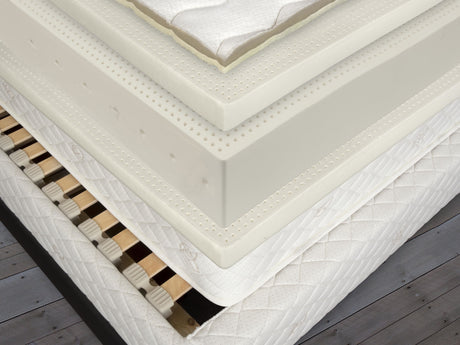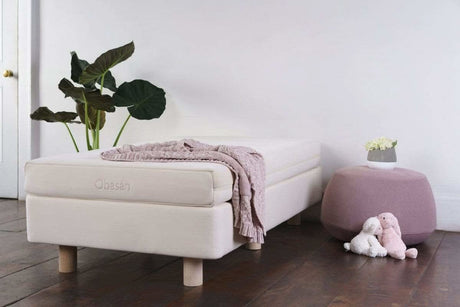Latex mattresses have been available for over 80 years. While new to most of us in North America, natural latex foam is a proven performer with several fantastic advantages. Just like many other products, there are many good examples of latex mattresses and, of course, many poor examples. Even if you read only a portion of this page, you'll arm yourself with an expert amount of knowledge on latex mattresses and sleep products.
This guide was originally published in 2008. We have updated and improved this informational guide over the years. The latest revisions occurred in May 2025.
What is latex foam?

Latex foam is an excellent choice for those seeking a durable, supportive sleep surface. Latex foam conforms properly to body shape, providing correct support for the whole body. Latex mattresses have a well-deserved reputation for exceptional durability, when made to a high-quality standard by brands such as Berkeley Ergonomics and Obasan.
Natural rubber is a polymer of isoprene (polyisoprene), and is sourced from the milk of the rubber tree. Typically, a few percent of other materials, such as proteins, fatty acids, resins, and inorganic materials, are found in high-quality natural rubber.
Synthetic latex foam in the mattress industry is made from oil-derived styrene-butadiene. This means the synthetic variety of latex differs greatly when compared to natural rubber. As most latex sold in Canada is synthetically blended, it is very important to know the differences when comparing. While it is technically possible to produce polyisoprene from petrochemical sources, and this would indeed be similar to natural latex foam in many respects, this is simply not the case with respect to what is available in the market.
What is natural latex?
Natural latex is made from the milk of the Pará rubber tree (Hevea brasiliensis). The common abbreviation for this is NR, standing for Natural Rubber. Natural rubber is resistant to dust mites and other allergens that common polyurethane foams are susceptible to building up over time. Natural rubber is a renewable resource.
Natural rubber is significantly more elastic than full synthetic or blended latex. This means it is able to stretch more without breaking and to rebound similarly to a steel spring, which makes for a much more responsive and supportive foam. This elasticity is the basic foundation of what makes natural rubber so desirable in many applications. Natural rubber is better able to conform to body shape and is more resistant to compression, meaning it is more durable than synthetic or blended latex. Natural latex foam typically is 3-4 times denser than the standard polyurethane foams used in mass-produced mattresses (exceptions for certain higher grades of polyurethane).

The Mattress & Sleep Company offers 100% natural rubber from Berkeley Ergonomics and Obasan.
What is synthetic latex?
Synthetic latex is created from petrochemicals. It is known as Styrene-Butadiene-Rubber, the common abbreviation of SBR. Sleep products will feature either natural or synthetic latex, or a combination of both; the most common blend being 30% Natural, 70% Synthetic.
It is important to note that because natural latex is a polymer of polyisoprene, synthetic latex is actually very different from natural latex. Thus, the performance of synthetic latex is not on a level comparable to natural rubber. Synthetic latex foam is springier and more elastic than standard polyurethane foam. However, it is simply inferior to pure natural latex.
Most latex sleep products sold in Canada are of the synthetic or synthetic-blended variety. Our offerings are either 100% natural rubber tree latex or they are a blend of rubber tree latex and synthetic latex. Every latex product we offer is clearly marked to distinguish the difference. As of this writing, we only offer one specific pillow with blended latex. Everything else is 100% natural.
How is latex foam made?
With the Dunlop Process, air is mechanically mixed into the liquid Hevea milk to form the wet foam. This material is then steamed to vulcanize the rubber. The foam goes through a thorough washing and drying process. The organic Dunlop rubber used in Obasan products is made by Arpico (Richard Pieris Natural Foams Ltd.) in Sri Lanka.
In the Talalay process, the basic foam is cast into an aluminium mould, which is only partially filled. The aluminium mould is then closed, and a vacuum is created. The foam is then frozen to -30 degrees Celcius, which ensures preservation of the round cell structure. This creates a consistent, open cell structure which ensures durability and allows airflow. It then goes through a similar washing and drying process to that of Dunlop latex. The roundness of Talalay cells creates more responsiveness and is more elastic than Dunlop rubber.
Many foam makers tout Talalay as being "new". The Talalay process has, in fact, been around since 1940, nearly as long as the Dunlop process. The highest quality Talalay latex in the world is produced by Radium in the Netherlands under the trade name Vita Talalay and is found in our Berkeley Ergonomics mattresses.
What are the advantages of latex?
- Instantly responds to body shape, ensuring proper conformance and support.
- Excellent air circulation.
- Excellent breathability, better with the Talalay process than with the Dunlop process
- It is not heat sensitive and performs well at any normal temperature.
- Pressure relief; less tossing and turning, resulting in rejuvenating sleep.
- An excellent life span, 10 to 20 years of comfortable life, is not uncommon for a high-quality natural rubber mattress. The life span of a synthetic or synthetically blended latex foam mattress will be shorter.
- Environmentally friendly; biodegradable. (only 100% natural rubber tree latex)
- High-quality natural rubber is inherently anti-microbial, dust mite resistant, and hypoallergenic.
What are latex fillers?
Latex fillers are fine particles of chemically inert materials such as calcium oxide, China Clay (Kaolin clay) or titanium dioxide. They are used in low-quality latex foam production, as they can greatly reduce the cost of producing latex foam.
Using fillers destroys the hypoallergenic properties of latex, which severely limits the health benefits that latex foam normally provides.
There are absolutely no fillers in any of the high-quality Berkeley Ergonomics and Obasan products available from The Mattress & Sleep Company.
Price is typically a very good indicator of what you're getting when comparing latex options. When in doubt, do not hesitate to ask the salesperson or the store to show you documentation on the latex composition.
Myth: Dunlop latex is firmer than Talalay latex
As with many myths, there is an element of truth to this. We still refer to this as a myth because, as with all types of foam, there is an enormous range in firmness and density options available. So it is possible to have a very firm feeling piece of Talalay process foam and a very soft piece of Dunlop process foam.
The reason this myth regularly comes up is due to the cell structure of the foams being inherently different. Technically, all upholstery foams become firmer as they are compressed. This is known as the foam's compression modulus. The higher the compression modulus, the faster the foam will become firmer as it is compressed.
There are 2 reasons why there is this difference in the perceived comfort of the foams.
First is the shape of the cells that make up the foam. With the Talalay production method, the cell structure of the foam is created with vacuum pressure to expand the liquid rubber inside the Talalay moulds, which are sealed. The evenness of vacuum pressure creates very round and similarly sized cells (this is why it is referred to as 'more consistent'). With the Dunlop method, air is mixed in mechanically, creating a wider variety in both size and shape of the cells.
Secondly, the freezing process of the Talalay production method bursts open the cells of the foam before the final curing process. This openness of the cells provides a dramatic increase in breathability, which not only benefits temperature and humidity but prevents air from becoming trapped in the rubber cells of the foam. Some air will become trapped in less breathable foams, which is then in turn pressurized as the mattress is compressed.
To simplify, it could be said that Dunlop has a more progressive firm feel that is a little more stable and less bouncy than Talalay; Talalay has a more linear firmness that has a more buoyant feel than Dunlop Latex.
It is also for the above reasons that we avoid listing the ILD or IFD specification of the layers of latex in our various mattresses, as it does not accurately describe on its own the firmness or comfort of a mattress. There is more to the character and comfort of a mattress than firmness, which is only one aspect.
Myth: All Talalay latex is synthetic
This is untrue. Talalay simply refers to one of the processes for creating latex foam. The actual source material can be either natural latex, synthetic, or a blend of the two.
The vast majority of Talalay latex is synthetically blended. The blend percentage is often in the range of 30% natural rubber tree milk and 70% petrochemical (styrene-butadiene). The Vita Talalay latex used by Berkeley Ergonomics is made from 100% rubber tree milk.
Myth: All Talalay latex is natural
Ironically, the other myth we commonly encounter is that all Talalay latex is natural. This is again untrue. Most Talalay latex is a blend of styrene-butadiene and rubber tree milk. There are, of course, options such as the Berkeley Ergonomics previously mentioned, where the entire polymer content is made up of rubber tree milk, meaning this would be considered natural. When rubber tree milk is blended with styrene-butadiene, even in small percentages, we simply do not consider this a natural foam.
Concern: I’m allergic to latex.
Although latex allergies are cause for concern, the type of latex used in mattresses and pillows is incredibly safe. Latex is a touch allergy, which means you have to come in direct contact with it to have a reaction. All of the natural latex products we offer are covered, ensuring no direct contact. We have also had customers who are nurses and doctors with legitimate latex allergies to products like latex gloves, who are able to handle the raw latex foam without any issue.
There is another type of latex allergy, which is extremely rare and directly affects the respiratory system. It is more serious, however, incredibly rare, and there is no link between an increased risk of this allergy developing, even for the workers who collect raw milk from the trees.
If in doubt, we recommend buying a latex pillow for allergy test. We will take the price of the pillow off the price of the mattress, should the test be successful, and we will refund the pillow should there be strong evidence of an allergic reaction.
Which is better, synthetic or natural?
Under most circumstances, a strong case can be made for natural latex being the superior product.
Although synthetic latex does somewhat mimic the feel and comfort of natural latex, it does not offer many of the same health benefits, nor is it as durable. Natural latex contains proteins which severely limit the ability of dust mites and other bothersome allergens from congregating in your mattress.
Natural latex is desirable for its unique ability to stretch without breaking. Synthetic latex simply does not offer this same elasticity, which leads to a less durable, less supportive product.
One of the primary benefits of sleeping on a latex mattress is the ability of the mattress to conform properly to body shape. As the natural latex cells are more elastic and stretchable than standard synthetic latex, it is easy to see why its ability to conform to the complex shape of the human body is enhanced when using higher natural latex content.
When it comes to synthetic latex, the primary advantage remains to be one of price. Unfortunately, we do not have rubber trees in North America, which means anything made out of this material needs to be shipped from great distances. Natural latex is more expensive to produce as the harvesting process is relatively slow so as to ensure sustainability of the trees. For those who cannot justify the cost of 100% natural latex, a blend of natural and synthetic latex will keep the cost more reasonable. Although the vast majority of latex products we offer are 100% natural rubber tree latex, as of the latest update to this article (May 2025), The Mattress & Sleep Company does not offer any synthetically-blended latex products.
Vita Talalay Latex
Simply put, Vita Talalay latex is the highest performance latex available today. Given that this material has several unique properties and advantages over other varieties of latex, The Mattress & Sleep Company have created an entire page devoted to the topic of Vita Talalay.










